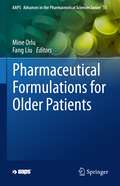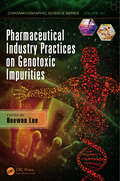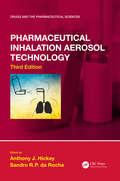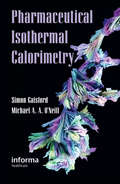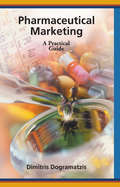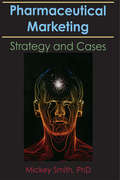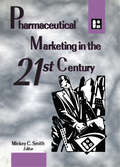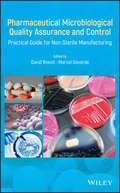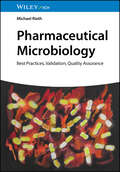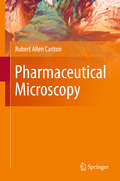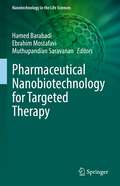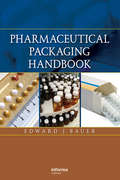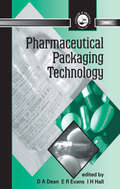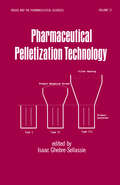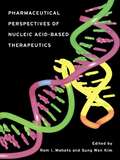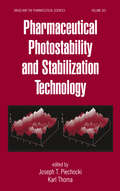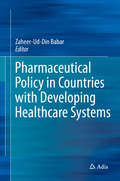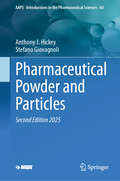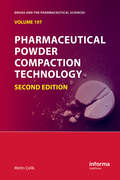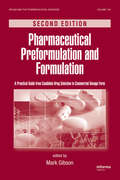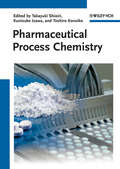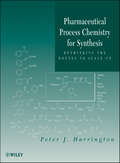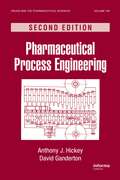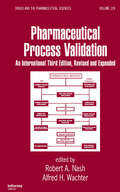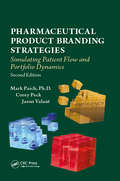- Table View
- List View
Pharmaceutical Formulations for Older Patients (AAPS Advances in the Pharmaceutical Sciences Series #51)
by Mine Orlu Fang LiuPharmaceutical formulation design affects patient acceptability/adherence and pharmacokinetics of the drug. This is particularly important for older patients because of the physiological changes due to ageing and clinical/social circumstances related to medicine taking.This book provides a comprehensive review in the design of formulations to meet the needs of older patients. An overview of the key clinical, social and pharmaceutical factors affecting medication optimization, safety and acceptability in older adults is included, followed by patient-centric considerations including regulatory requirements, dosage form design and human factor studies.Advanced pharmaceutical technologies are discussed for their potential use in older adults such as 3D printing, long-acting oral formulations and novel vaccine technologies. The unique focus of the book will be of interest to pharmaceutical scientists in both industry and academia in searching for better formulations for older patients.
Pharmaceutical Industry Practices on Genotoxic Impurities (Chromatographic Science Series)
by Heewon LeeA great deal of confusion and uncertainty over genotoxic impurity (GTI) identification, assessment, and control exists in the pharmaceutical industry today. Pharmaceutical Industry Practices on Genotoxic Impurities strives to facilitate scientific and systematic consensus on GTI management by presenting rationales, strategies, methods, interpretati
Pharmaceutical Inhalation Aerosol Technology, Third Edition (Drugs and the Pharmaceutical Sciences #134)
by Anthony J. Hickey Sandro R. da RochaThis fully revised and updated third edition of Pharmaceutical Inhalation Aerosol Technology encompasses the scientific and technical foundation for the rationale, design, componentry, assembly and quality performance metrics of therapeutic inhalers in their delivery of pharmaceutical aerosols to treat symptoms or the underlying causes of disease. It focuses on the importance of pharmaceutical engineering as a foundational element of all inhaler products and their application to pulmonary drug delivery. The expanded scope considers previously unaddressed aspects of pharmaceutical inhalation aerosol technology and the patient interface by including aerosol delivery, lung deposition and clearance that are used as measures of effective dose delivery.
Pharmaceutical Isothermal Calorimetry
by Simon Gaisford Michael A. O'NeillPharmaceutical Isothermal Calorimetry discusses the application of isothermal calorimetric techniques to challenges encountered during the rational design and development of novel drugs and drug delivery systems. Providing a comprehensive review of recent research and trends, this book contains an expert discussion of research and applications to p
Pharmaceutical Marketing: A Practical Guide
by Dimitris DogramatzisDesigned as a practical guide for the pharmaceutical industry, this book covers how to apply cutting-edge marketing concepts and tools to the real-world intricacies of marketing a heavily regulated product whose success is determined not by the actual end-user, but by various industry stakeholders. From creating a worldwide vision that cascades into local tactics to managing a drug portfolio or pricing a particular product, this book guides readers through developing, implementing, and auditing a successful marketing strategy geared specifically to the pharmaceutical industry. It provides graphs, tables, worksheets, pharmaceutical case studies, and a sample marketing strategy.
Pharmaceutical Marketing: Strategy and Cases
by Mickey C. SmithReflecting the fascinating and dramatic changes in pharmacy, pharmaceutical education, and the pharmaceutical industry in recent years, this authoritative volume focuses on the practice of marketing both prescription and nonprescription medications. In a dozen comprehensive chapters, author Mickey Smith highlights the economic social, and
Pharmaceutical Marketing in the 21st Century
by Mickey SmithA group of experts, leaders in their fields, provide a formal conjecture on the nature of various aspects of pharmaceutical marketing in the early part of the twenty-first century. Pharmaceutical Marketing in the 21st Century is ideal for product managers, planners, and strategists as it provides guidance for the future of marketing pharmaceutical products. Internationally relevant, this book is now available in Japanese!
Pharmaceutical Microbiological Quality Assurance and Control: Practical Guide for Non-Sterile Manufacturing
by David Roesti Marcel GoverdeRelying on practical examples from the authors’ experience, this book provides a thorough and modern approach to controlling and monitoring microbial contaminations during the manufacturing of non-sterile pharmaceuticals. Offers a comprehensive guidance for non-sterile pharmaceuticals microbiological QA/QC Presents the latest developments in both regulatory expectations and technical advancements Provides guidance on statistical tools for risk assessment and trending of microbiological data Describes strategy and practical examples from the authors’ experience in globalized pharmaceutical companies and expert networks Offers a comprehensive guidance for non-sterile pharmaceuticals microbiological QA/QC Presents the latest developments in both regulatory expectations and technical advancements Provides guidance on statistical tools for risk assessment and trending of microbiological data Describes strategy and practical examples from the authors’ experience in globalized pharmaceutical companies and expert networks
Pharmaceutical Microbiology: Best Practices, Validation, Quality Assurance
by Michael RiethAll-in-one guide to monitoring and maintaining microbiological safety in the manufacturing of pharmaceuticals, diagnostics, and cosmetics Addressing the full spectrum of microbiological quality control and quality assurance in pharmaceutical production, Pharmaceutical Microbiology covers methods and technologies required by regulatory authorities throughout the world, with all methods and protocols rated in terms of their compliance with current (2023) EU legislation. Written by the former head of biological quality assurance for one of Europe’s biggest pharmaceutical and diagnostics companies, Pharmaceutical Microbiology covers sample topics including: General conditions for the operation of microbiological laboratories, calibration and qualification of devices, and type culture maintenanceIndustrial hygiene, ambient monitoring, quality control, process validation, microbiological water examination, and rapid microbiological methodsAutomation in the microbiology laboratory, quality assurance, identification of microorganisms, cleaning, sterilization, decontamination, and disposal, and contract testingPharmacopoeial and non-pharmacopoeial methods for the identification and quantification of microorganisms, including cell culture and selected animal tests Pharmaceutical Microbiology is an essential practice-oriented all-in-one reference for engineers, researchers, and professionals involved in setting up and running a microbiological quality control unit in the pharmaceuticals, diagnostics, and cosmetics industries.
Pharmaceutical Microscopy
by Robert Allen CarltonMicroscopy plays an integral role in the research and development of new medicines. Pharmaceutical Microscopy describes a wide variety of techniques together with numerous practical applications of importance in drug development. The first section presents general methods and applications with an emphasis on the physical science aspects. Techniques covered include optical crystallography, thermal microscopy, scanning electron microscopy, energy dispersive x-ray spectrometry, microspectroscopy (infrared and Raman), and particle size and shape by image analysis. The second section presents applications of these techniques to specific topics of pharmaceutical interest, including studies of polymorphism, particle size and shape analysis, and contaminant identification. Pharmaceutical Microscopy is designed for those scientists who must use these techniques to solve pharmaceutical problems but do not need to become expert microscopists. Consequently, each section has exercises designed to teach the reader how to use and apply the techniques in the book. Although the focus is on pharmaceutical development, workers in other fields such as food science and organic chemistry will also benefit from the discussion of techniques and the exercises. Provides comprehensive coverage of key microscopy techniques used in pharmaceutical development Helps the reader to solve specific problems in pharmaceutical quality assuranceOriented and designed for pharmaceutical scientists who need to use microscopy but are not expert microscopistsIncludes a large number of practical exercises to give the reader hands-on experience with the techniquesWritten by an author with 21 years of experience in the pharmaceutical industry
Pharmaceutical Nanobiotechnology for Targeted Therapy (Nanotechnology in the Life Sciences)
by Hamed Barabadi Ebrahim Mostafavi Muthupandian SaravananThe field of nanotechnology for targeted therapy initiated more than decade ago has grown fast and interest is increasing. Given the importance of the field for targeted drug and gene delivery systems, there are a large number of laboratory investigations today researching nanobiomaterials for diagnostic and therapeutic applications. Because of the ability of scientists to load nanoparticles with any agent, interest continues to grow and technology in this arena is rapidly evolving. These emerging nanobiomaterials-based medicines can overcome the disadvantages of traditional medicines by target-oriented and site-specific delivery of precise medicines (immunotherapeutic agents, chemotherapeutic agents, diagnostic agents, and so on). Pharmaceutical Nanobiotechnology for Targeted Therapy presents an updated overview of recent advancements in the field of pharmaceutical nanobiotechnology and nano-based drug and gene delivery systems. This comprehensive knowledge will allow researchers to discover innovative nanobiomaterials for targeted therapeutics. The chapters deal with various emerging nanobiomaterials for targeted therapeutic delivery systems and the writing is in a style that is easily disseminated and in a manner that can be readily adopted as sources for new and further studies. This book should be useful for researchers and professionals from academia and industry working in the field of nanotechnology, nanobiotechnology, as well as in the field of pharmaceutical nanotechnology. It should also be useful to those interested in a range of disciplines from material science, chemistry, molecular biology, polymer chemistry, and many more interdisciplinary areas.
Pharmaceutical Packaging Handbook
by Edward BauerPharmaceutical Packaging Handbook provides a complete overview of the role that packaging plays in the development and delivery of pharmaceuticals and medical devices. Supplying a thorough examination of the industry in size and scope, the book covers drug dosage forms, vaccines, biologically produced products, and medical foods.Features:Discusses
Pharmaceutical Packaging Technology
by D. A. Dean E. R. Evans I. H. HallPharmaceutical packaging requires a greater knowledge of materials and a greater intensity of testing than most other packed products, not to mention a sound knowledge of pharmaceutical products and an understanding of regulatory requirements. Structured to meet the needs of the global market, this volume provides an assessment of a wide range of i
Pharmaceutical Pelletization Technology
by Isaac Ghebre-SellassieThis book serves as a formulation and processing guide during the development of pelletized dosage forms. It provides the pharmaceutical technologist with basic information about the design aspects of the relevant processing equipment.
Pharmaceutical Perspectives of Nucleic Acid-Based Therapy
by Ram I. Mahato Sung Wan KimEmphasizing its uses in cancer and cardiovascular and autoimmune diseases, Pharmaceutical Perspectives of Nucleic Acid-Based Therapy presents a comprehensive account of gene therapy, from development in the laboratory to clinical applications. Internationally acclaimed scientists discuss the potential use of lipids, peptides and polymers for the in
Pharmaceutical Photostability and Stabilization Technology
by Joseph T. Piechocki Karl ThomaBased on a training course developed by Dr. Joseph T. Piechocki and other experts in this field whose contributions appear in this book for two International Meetings on the Photostability of Drugs and Drug Products, this text clarifies the guidelines set by the International Conference on Harmonization (ICH) and provides a comprehensive background
Pharmaceutical Policy in Countries with Developing Healthcare Systems
by Zaheer-Ud-Din BabarA comprehensive and granular insight into the challenges of promoting rational medicine, this book serves as an essential resource for health policy makers and researchers interested in national medicines policies. Country-specific chapters have a common format, beginning with an overview of the health system and regulatory and policy environments, before discussing the difficulties in maintaining a medicines supply system, challenges in ensuring access to affordable medicines and issues impacting on rational medicine use. Numerous case studies are also used to highlight key issues and each chapter concludes with country-specific solutions to the issues raised. Written by highly regarded academics, the book includes countries in Africa, Asia, Europe, the Middle East and South America.
Pharmaceutical Powder and Particles (AAPS Introductions in the Pharmaceutical Sciences #60)
by Anthony J. Hickey Stefano GiovagnoliThis book in the AAPS book series concisely reviews important aspects of powder and particle systems and the critical quality attributes that should be used as a guide to future developments intended to maximize the control of product quality and performance. Hickey and Giovagnoli have written an essential book for any scientists involved in powder or particle research and manufacturing. It is appropriate for those just entering the field or as a rapid reference for the experienced pharmaceutical scientist. The authors have both academic and industrial experience, and the coverage includes solid state chemistry; crystallization; physical processes; particle size and distribution; particle interaction; manufacturing processes; quality by design; and a general discussion of the industry. Pharmaceutical Powder and Particles is intended to concisely review important aspects of powder and particle systems and the critical quality attributes that should be used as a guide to future developments intended to maximize the control of product quality and performance. Innovation in manufacturing has expanded the range of options available for solid dosage form manufacture while continuing to rely on first principles of solid-state chemistry and characterization methods for powders and particles. In this new edition, the authors have expanded on existing chapters and added sections on new developments in the recent and evolving manufacturing processes including additive manufacturing technologies, controlled crystallization, spray-freeze-drying technology, and more. The editors have also comprehensively updated the references throughout the entire book.
Pharmaceutical Powder Compaction Technology (Drugs and the Pharmaceutical Sciences)
by Metin ÇelikCompaction of powder constituents-both active ingredient and excipients-is examined to ensure consistent and reproducible disintegration and dispersion profiles. Revised to reflect modern pharmaceutical compacting techniques, this second edition of Pharmaceutical Powder Compaction Technology guides pharmaceutical engineers, formulation scientists,
Pharmaceutical Preformulation and Formulation: A Practical Guide from Candidate Drug Selection to Commercial Dosage Form (Drugs and the Pharmaceutical Sciences)
by Mark GibsonPharmaceutical Preformulation and Formulation: A Practical Guide from Candidate Drug Selection to Commercial Dosage Form reflects the mounting pressure on pharmaceutical companies to accelerate the new drug development and launch process, as well as the shift from developing small molecules to the growth of biopharmaceuticals. The book meets the ne
Pharmaceutical Process Chemistry
by Takayuki Shioiri Kunisuke Izawa Toshiro KonoikeCovering the whole area of process chemistry in the pharmaceutical industry, this monograph provides the essential knowledge on the basic chemistry needed for future development and key industrial techniques, as well as morphology, engineering and regulatory compliances. Application-oriented and well structured, the authors include recent examples of excellent industrial production of active pharmaceutical ingredients.
Pharmaceutical Process Chemistry for Synthesis
by Peter J. HarringtonThere is a need to explain that generic versions of a drug may not be manufactured by the same process as brand-name drugs and that the different processes may have dramatically different environmental impacts. Two global forces are at odds today--the push for "greener" processes and the push for lower drug prices. This book brings this conflict into sharp focus by discussing in detail the published process chemistry for top-selling small molecule drugs.Providing insights about process route selection, choice of reagents, and reaction conditions, Pharmaceutical Process Chemistry for Synthesis guides process chemists in identifying best processes for manufacturing these blockbuster drugs as they lose patent protection. Further, it highlights the strategies and methodology that might be useful for expediting the process research and development of the blockbusters of the future.Written from a refreshingly objective perspective, this book is essential for process chemists who need to devise practical syntheses for increasingly complex drugs in a constantly decreasing time frame.
Pharmaceutical Process Engineering (Drugs and the Pharmaceutical Sciences)
by Anthony J. Hickey David GandertonWith step-by-step methods of drug production and knowledge of major unit operations and key concepts of pharmaceutical engineering, this guide will help to improve communication among the varied professionals working in the pharmaceutical industry. Key features: REVISION OF A BESTSELLER - Updates include recent advances in the field to keep pharmac
Pharmaceutical Process Validation: An International (Drugs and the Pharmaceutical Sciences)
by Robert A. Nash Alfred H. WachterThe third edition of this text contains additional chapters which cover troubleshooting procedures, validation in contract manufacturing and current harmonization trends.
Pharmaceutical Product Branding Strategies: Simulating Patient Flow and Portfolio Dynamics
by Mark Paich Corey Peck Jason ValantThis updated Second Edition details how marketers, forecasters, and brand planners can achieve optimal success by building internally consistent simulation models to project future behavior of patients, physicians, and R&D processes. By introducing the reader to the complexities facing many pharmaceutical firms, specifically issues around cross-functional coordination and knowledge integration, this guide provides a framework for dynamic modeling of interest to several pharmaceutical markets, including epidemiology, market definitions, compliance/persistency, and revenue generation in the context of patient flows or movements.
